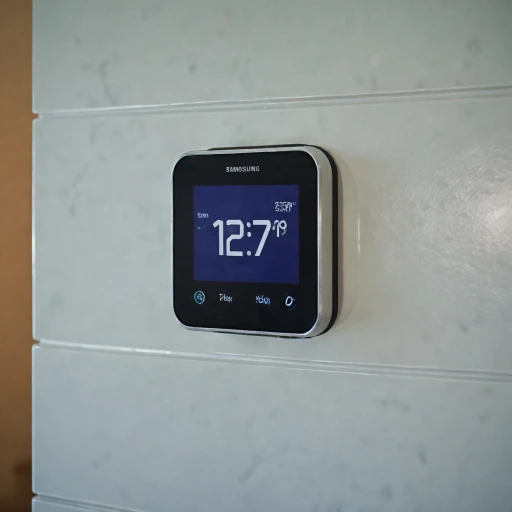What is the Consumers Energy Nest Thermostat Partnership?
The Collaboration between Consumers Energy and Nest Thermostat
The partnership between Consumers Energy and Nest Thermostat represents a significant step forward in energy management for customers. This collaboration aims to enhance the function and usability of smart thermostats for Consumers Energy's consumers, providing them with a more efficient and rewarding experience. Nest thermostats, developed by Google, are smart devices designed to optimize the use of energy through intelligent heating and cooling management. Consumers Energy, a major utility provider, recognizes the potential of smart thermostats to help customers reduce their energy consumption and save on utility bills. Through this partnership, customers are introduced to the Nest Thermostat Program, which offers a variety of benefits, from convenience to cost savings. Both companies have worked together to create a rewards program where customers can earn incentives, such as prepaid Mastercards, for participating in energy-saving initiatives. This program not only encourages the adoption of smart thermostats but also provides consumers with tangible rewards for their energy-saving efforts. Moreover, this partnership addresses the growing demand for energy conservation and the reduction of natural gas usage. As climate concerns continue to rise, integrating smart technology into everyday living plays a crucial role in future-proofing energy consumption habits. In addition to financial rewards, the program offers a seamless way to integrate smart thermostats into homes and businesses, helping customers manage their heating and cooling more effectively. This initiative is a step toward sustainable energy solutions, benefiting not only individual consumers but also contributing to broader environmental goals. For more information about smart thermostats and their functionalities, check out this guide on using your thermostat.How Smart Thermostats Work
How Smart Thermostats Function
Smart thermostats have revolutionized how we manage energy consumption, providing more control over heating and cooling systems in homes and businesses. By integrating advanced technology and user-friendly interfaces, these devices cater to the evolving needs of consumers seeking convenience and efficiency. Smart thermostats like the Google Nest fundamentally alter the way users interact with their heating and cooling systems. These devices are equipped with sensors that detect temperature changes and presence in rooms, allowing them to adjust settings automatically. This not only conserves energy but also tailors the indoor climate to suit personal preferences, ensuring comfort and efficiency. Moreover, connectivity plays a crucial role in how these thermostats operate. Many models connect to Wi-Fi, enabling remote access and control via smartphone apps or through integration with smart home platforms like Google Home. This connectivity also allows for real-time feedback and control, ensuring that customers can monitor their energy usage and make informed adjustments.- Programmable Schedules: Users can set specific heating and cooling schedules, often resulting in energy savings during off-peak times.
- Adaptive Learning: Some smart thermostats learn users’ routines over time, optimizing the heating and cooling cycles accordingly.
Benefits of Using a Nest Thermostat with Consumers Energy
Maximizing Efficiency and Savings with the Integration
The integration of the Nest Thermostat with Consumers Energy offers numerous benefits for customers, enabling them to save both energy and money. One significant advantage is the ability to effectively manage your heating and cooling systems through a smart thermostat. This connection provides enhanced control over energy usage, allowing consumers to efficiently utilize electricity and natural gas. Nest thermostats, developed by Google, utilize advanced algorithms to learn your schedule and preferences, adjusting temperature settings automatically. This intelligent approach helps in reducing unnecessary energy consumption, contributing to lower utility bills. The program is designed to help customers minimize waste while maintaining a comfortable environment inside their homes. Moreover, participating in the Consumers Energy program can earn rewards. Customers may receive additional incentives such as a prepaid Mastercard or other rebates through the rewards program. These financial perks serve as an added motivation to adopt smart thermostats, not only for energy savings but also for potential monetary benefits. The partnership also supports consumers by providing google-based customer support and resources to guide them in optimizing their Nest thermostat settings for maximum efficiency. This can be especially useful for those new to smart technology and wishing to fully harness the capabilities of their device. For businesses and real estate, this integration can signify an improvement in sustainability efforts and can be seen as a positive bonus when marketing their properties. In sectors like healthcare, where maintaining optimal temperature is crucial, a smart thermostat can provide a viable solution to ensure both energy savings and comfort. By adhering to terms and conditions laid out by Consumers Energy, customers can take full advantage of the Nest thermostat program and all its associated benefits. To explore further about optimizing smart thermostats, you can refer to this comprehensive guide. Staying informed with the latest news and updates will ensure you are aware of new opportunities to enhance your energy efficiency.Installation and Setup Process
Getting Started with Your Nest Thermostat
Setting up a Nest Thermostat with Consumers Energy's integration offers an enhanced experience for consumers looking to optimize their heating and cooling needs. Whether you aim to join Google's Nest program or utilize the thermostat's smart capabilities, this guide will provide an overview to help you get started. Installation Steps- Prepare for Installation: First, ensure you have the necessary tools and a stable internet connection. The Nest Thermostat package should contain the device, a mounting plate, screws, and a power adapter if required.
- Turn Off Your System: Before removing your old thermostat, turn off the power to your HVAC system. This is crucial for safety and to avoid damaging the new thermostat.
- Mount the Nest Thermostat:
- Remove your old thermostat, making sure to label each wire as you disconnect it.
- Attach the mounting plate of the Nest Thermostat to the wall using screws.
- Connect the previously labeled wires to the Nest base following the wiring diagram provided.
- Connect to Wi-Fi and the Nest App: With the hardware installed, power your system back on. Connect the thermostat to Wi-Fi using the on-screen instructions, and download the Google Nest app to pair the thermostat with your account.
- Link with Consumers Energy: To integrate your Nest Thermostat with Consumers Energy, log into your utility account and sign up for any available Rewards Programs. By doing so, not only can customers potentially earn rewards, but they may also receive additional benefits like a prepaid Mastercard under specific terms and conditions.
- Use Google's Support: Utilize Google Uplight's resources or join related groups on platforms like Facebook or Twitter for community support.
- Ensure Compatibility: Double-check that your heating and cooling system is compatible with the Nest Thermostat to make the most of its smart features.
Troubleshooting Common Issues
Resolving Common Setbacks with Smart Thermostat Setup
As you embark on the journey to leverage the integration of Nest Thermostat with Consumers Energy, you might encounter some typical issues during installation or daily operations. Here, we aim to navigate through some frequently faced challenges and offer solutions to enhance your experience.
Connection Issues: Ensure your Nest thermostat is connected to a stable Wi-Fi network. Connection problems are often due to weak signals or temporary network glitches. Restart your router and the thermostat to help re-establish a solid connection, allowing the smart thermostat to operate seamlessly through the Google Nest ecosystem.
Temperature Control Discrepancies: Sometimes you might notice a discrepancy between the set temperature and what you feel in the room. It's essential to check if there are drafts near your device or if it's placed in direct sunlight, as these can affect its sensor readings. Repositioning your device or closing drafts will help maintain accurate thermostat readings, giving your home the optimal heating and cooling balance.
Program or Scheduling Settings: If your thermostat is not following the desired schedule, verify your settings through the thermostat app. Ensure all programming aligns with your daily routine and energy preferences. Minor adjustments might be needed to sync the thermostat’s functionalities with Consumers Energy’s platform and heating or cooling patterns.
Address Compatibility and Firmware Updates: Regularly update the thermostat firmware to ensure compatibility with Consumers Energy’s platform and benefit from new features or fixes. Prompt updates generally solve many small glitches and ensure your device functions optimally.
In addition, explore support resources provided by Google and Consumers Energy for assistance and guidelines tailored to solving typical thermostat issues.








